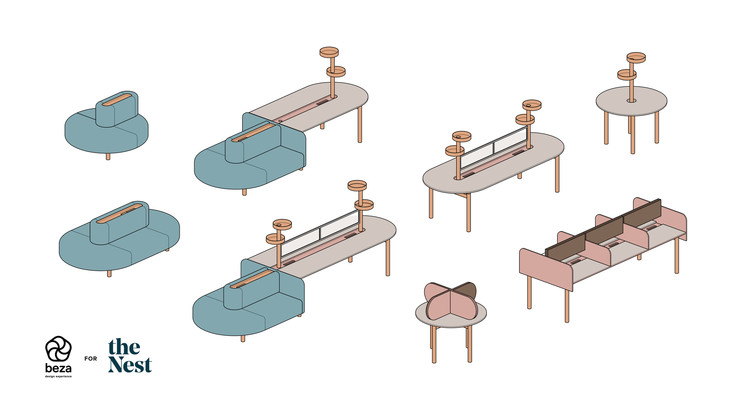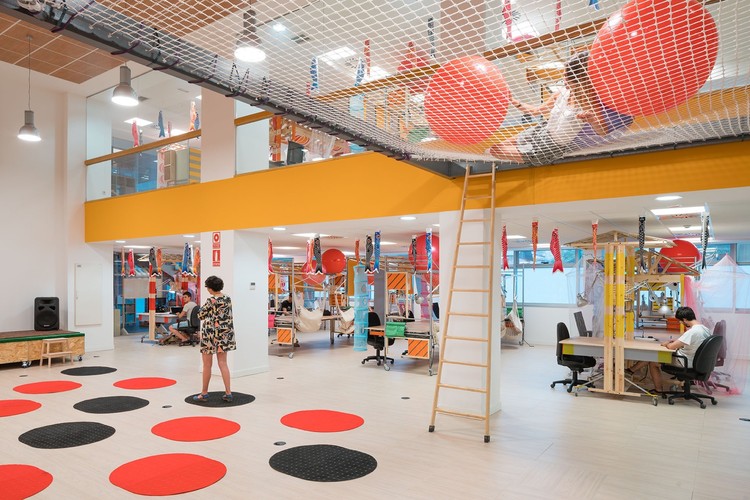5 Design Strategies to Improve Mental Health in Shared Workspaces
Burnout syndrome is an occupational phenomenon resulting from chronic workplace stress and emotional tension and has been affecting more and more professionals every day. It is directly associated with each person’s daily work life, not only with the operational aspects of the job but also the physical environment.
We spend on average 1/3 of our day in workspaces, so it’s no wonder they considerably affect our mental health. Following a period of intense home office activity during the year 2020, now people are returning to collaborative workplaces. These spaces offer a great alternative to escape the domestic environment and create separate places for each function of our lives, a much-needed change after a year of isolation.





The coworking business started around 2005 and became a worldwide trend. Since then, every professional has wished for a colorful, multi-purpose, vibrant workplace. However, it became clear that a cool and trendy room is not enough to ensure a healthy work environment, both physically and mentally. Neuroarchitecture has been demonstrating how environments can influence human behavior by studying the interactions between our brain and architecture, which can alter our emotional state, providing a sense of calm, tranquility, increasing productivity and focus, or the complete opposite.
Therefore, we have selected a few design strategies that are key to ensure the user’s well-being in shared workspaces.
Versatile furniture
Any coworking business that doesn’t have individual standing desks nowadays is pretty much outdated. According to British studies, these workstations offer numerous benefits, not only by improving posture but also by reducing the risk of cardiovascular diseases and even some types of cancer, such as prostate and ovarian cancer. Experts recommend working at least two hours a day standing up.
Apart from the physical benefits, different types of furniture also contribute to making work less monotonous, allowing for different interactions that can often increase the user’s motivation. One of the main concepts of the Polish coworking project Nest was to encourage changing work environments throughout the day by offering not only traditional desks but also armchairs, bleachers, sofas, and high tables. Using colors and textures, Nest offers a wide variety of tables and places to sit that inspire different perceptions of the same space.

Nest / Beza Projekt. © Jacek Kołodziejski

Nest / Beza Projekt. © Jacek Kołodziejski
Similarly, The Coven, an American coworking space designed especially for women and those who identify as non-binary, features a variety of furniture marked by an unexpected use of color and materials that reflect the individuality of the members and guests. The goal of the design was to empower those that inhabit the space and create a sense of community and equity by creating different spaces for interaction and personalization.

The Coven Co-working Space for Women / Studio BV. © Corey Gaffer Photography
Isolation vs. Interaction
On the subject of furniture, it is also important to create spaces for interaction as well as spaces for isolation so people can choose the best space for each specific moment and activity. Besides, the Covid-19 pandemic has increased the demand for more isolated workspaces to reduce the risk of contamination. The Arcoworking project, for example, was based on the concept of a dynamic environment that encourages people to meet each other, but the design also features more secluded spaces. The yellow booths provide space for small meetings or individual activities, while the large concrete counter allows for larger gatherings and events.

Arcoworking / Esquadra Arquitetos. © Joana França
Impact Hub Berlin uses the same approach, offering different settings ranging from communal tables to ‘Skype-boxes,’ which are small booths that can be used as individual workstations for immersion or videoconferences. They are made of wood, which brings warmth and coziness to the workplace, keeping in mind that textures, colors, and materials are crucial to a healthy environment.

Impact Hub Berlin Office Interiors / LXSY Architekten. © Anne Deppe
However, it is worth pointing out that according to some studies, the optimal size of an individual workstation is 1.20 meters, smaller desks are likely to become too confined.
Multipurpose rooms
Spending eight hours straight in front of a computer screen is anything but healthy, which is why collaborative workspaces have focused a lot on offering different kinds of activities to unwind and relax both body and mind. Many coworking facilities have rooms with music and illustrations on the walls or viewpoints on the balcony or terrace overlooking the landscape to help users rest their eyes and their mind.
Some companies even include yoga and meditation rooms, as well as relaxation areas for games and other fun activities. One good example of this is the Coworking utopic_US in Spain. Hammocks, colorful balls, and hanging chairs add playfulness to the environment while inspiring the users and showing that everything around them can be transformed into something unexpected.

Co-working utopic_US Conde de Casal / Izaskun Chinchilla. © Imagen subliminal

Co-working utopic_US Conde de Casal / Izaskun Chinchilla. © Imagen subliminal
However, playfulness does not necessarily require different materials, textures, and bright colors, as we can see in the Loona office. Even though it comes across as a more sober design, this workspace offers different areas for relaxation, such as the low-lit green room filled with plants or the room covered with cushions on the floor.

Office for Loona / Studio 11. © Aleksandra Kononchenko
Biophilia
When speaking of mental health, one cannot forget to mention the importance of being in contact with nature, so our fourth topic in this article is biophilia. This strategy is based on incorporating elements and aspects of nature into the built environment, such as water, plants, daylight, and natural materials such as wood and stone. Using more organic shapes and silhouettes rather than straight lines is also a key feature in biophilic designs, as well as establishing visual relationships between light and shadow, for example.
The Second Home Holland Park is a great example of biophilia in collaborative workspaces. First of all, the floor plan is very unusual for a work environment, featuring small ambiances that create an organic walk through the stations. The 18 trees planted within the workplace and the skylights contribute to a strong connection between nature and office routine. Like in neuroarchitecture, natural lighting is one of the cornerstones for the user’s well-being, being closely related to feelings of warmth and coziness.

Second Home Holland Park / Selgascano. © Iwan Baan

Second Home Holland Park / Selgascano. © Iwan Baan
This project is also very special because Richard Rogers had his very first personal studio there after winning the competition for the Pompidou Centre. The vine that Richard Rogers himself planted in the courtyard is a piece of natural design added to the history of the building, and that has survived even after renovations.
Outdoor areas
This last topic has become a major tool in improving people’s mental wellbeing, especially in the context of the covid-19 pandemic. It combines the items already mentioned above, such as the importance of having spaces for relaxation and interacting with natural elements. Outdoor areas in coworking spaces can be achieved through small patios, backyards, or gardens, as well as rooftops. The goal is to provide fresh air and access to the weather outside.
People who work many hours non-stop must take these breaks to improve their mental well-being, and the Pobre Diablo Cultural Factory in Quito, Ecuador, provides these opportunities through its outdoor spaces surrounding the office and the openings on the roof, which allow plants to grow and sunlight to come in.

Former Pobre Diablo Cultural Factory / Daniel Moreno Flores. © Bicubik Photography

Former Pobre Diablo Cultural Factory / Daniel Moreno Flores. © Bicubik Photography
Neuroarchitecture has been focusing more and more on exterior spaces as tools that can directly affect the brain, like charging a cell phone battery. Regardless of the level of greenery, outdoor areas are very important to take a moment to disconnect and recharge our energy.
These strategies can, and should, be applied to any work environment, including your own home office. No matter the scale, the key is to understand the importance of the physical space in the mental health of those who use it and how specific strategies can improve people’s quality of life.
